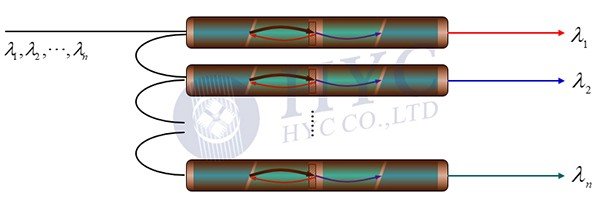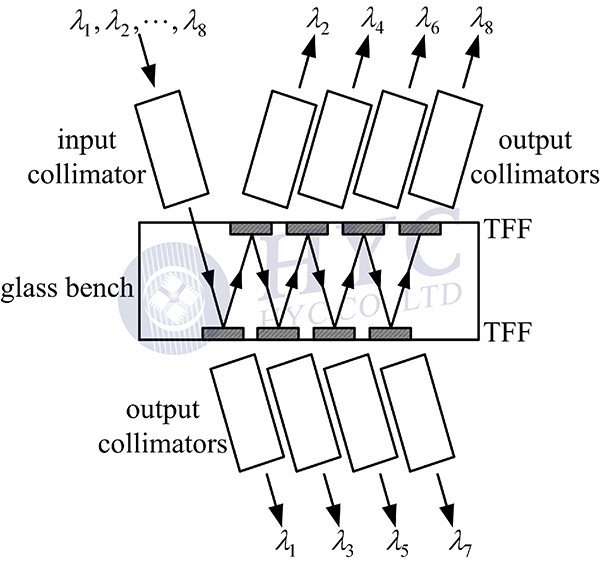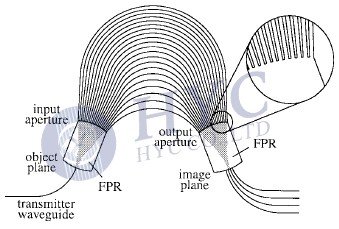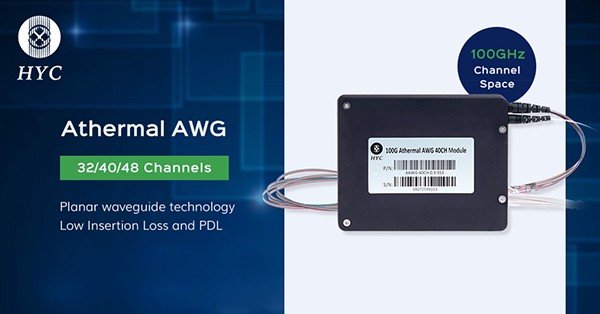Why is AWG demanded?
As we know, DWDM technology enables transmission of dozens of wavelengths in a single fiber, which expands the capacity of optical fiber communication enormously. The first mux/demux modules for DWDM system are based on thin-file filters (TFFs), as shown in Fig.1 and Fig.2. Both are designed in serial structure. Different wavelengths travel different number of devices in the module and result in different power loss. The loss uniformity degrades with increment of port number. Meanwhile, the maximum loss at the last port is another limitation on the port number. Thus the TFF-based WDM modules are usually limited to be ≤16 channels.


However, a typical DWDM system needs to transmit 40 or 48 wavelengths in a single fiber. Multiplexer/demultiplexer with high port number is required. A serial structure will accumulate too much loss at the last ports. Thus a parallel structure is demanded, which can multiplex/demultiplex dozens of wavelengths at the same time. Arrayed waveguide grating (AWG) is such a device.
Structure of AWG
Structure of a typical AWG is shown in Fig.3. It consists of five parts: a transmitter waveguide, an input star coupler (FPR (free propagation region) in Fig.3), arrayed waveguides, an output star coupler and dozens of receiver waveguides. The lengths of the arrayed waveguides are in arithmetic progression. Given L0 as the length of the first waveguide, the length Li of the i-th waveguide is as follow.


The DWDM signals emit from the transmitter waveguide and are separated into the arrayed waveguides after free propagation in the input star coupler. The separation is colorless, which means that all the wavelengths are separated into the arrayed waveguides identically. The arrayed waveguides generate phase difference between the multiple optical beams. The phases of the multiple beams are in arithmetic progression, which is just like the traditional gratings. Thus the different wavelengths are dispersed and then focused at different positions in the output star coupler. The receiver waveguides are set at the focusing positions. Different wavelengths are received by different waveguides and thus parallel demultiplexing of DWDM signals are realized.
Arrayed waveguide gratings (AWGs) are key components of DWDM (Dense Wavelength Division Multiplexing Systems) networks that are rapidly developing. The AWG can obtain a large number of wavelengths and channel numbers, realize multiplexing and demultiplexing of tens to hundreds of wavelengths, and can flexibly form multifunctional devices and modules with other optical devices. High stability and excellent cost performance are also one of the reasons why AWG has become the technology of choice for DWDM.
HYC launched a 48-channel (Athermal Arrayed Waveguide Grating) AAWG, mainly for 400Gbps network applications. Based on the array waveguide grating technology, it does not require additional power supply or temperature control, and is a pure passive module. It has the characteristics of low loss, polarization-dependent loss, low crosstalk, and good stability in the operating temperature range of -40 °C to 85 °C.

HYC Co., Ltd was founded in 2000, which a leading passive optical device OEM / ODM and solution provider in the global industry, focusing on R & D, manufacturing, sales and service of passive basic devices for optical communication. The company's main products are: optical fiber connectors, WDM, PLC optical splitters, and MEMS optical switches. HYC products and solutions widely applied in 4G/5G, Data Center and Cloud Computing industry etc.
Hi! I am a robot. I just upvoted you! I found similar content that readers might be interested in:
https://optical-passive.com/2019/09/29/wdm-devices-arrayed-waveguide-grating/
Downvoting a post can decrease pending rewards and make it less visible. Common reasons:
Submit